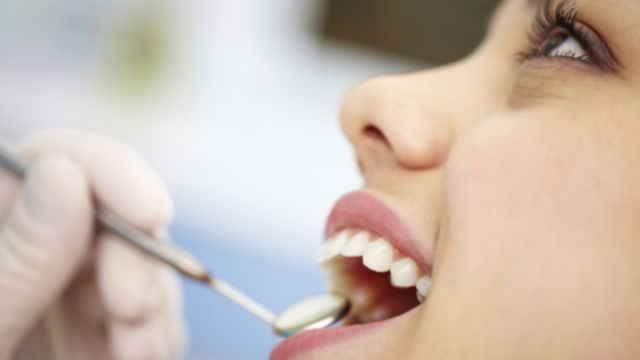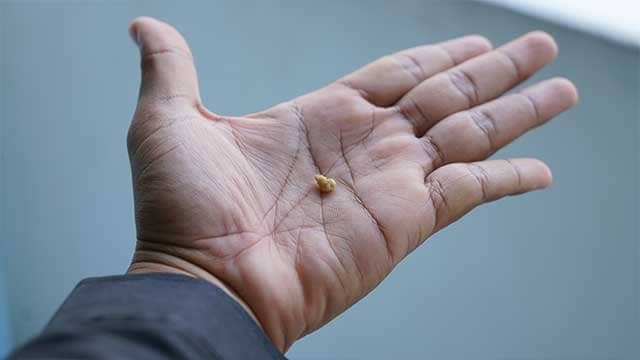What Are Dental Fillings?
A dental filling helps to restore both the shape and function of the affected tooth that has been damaged by tooth decay. When you undergo a dental filling procedure, the first step is to remove the decayed part of the tooth. After that, the dental professional thoroughly cleans the affected area. Finally, they use a filling material to fill the cleaned-out cavity.
Apart from restoring the tooth, a dental filling also plays a crucial role in preventing further decay by closing off any spaces that could allow bacteria to enter. Different materials can be used for dental fillings. These include gold, porcelain, composite resin material (tooth-coloured fillings), and amalgam (a mixture of mercury, silver, copper, tin, and sometimes zinc).
What Steps Are Involved in Filling a Tooth?
To understand what is a tooth filling, it is important to know the dental filling procedure, which is carried out by a dental professional. The steps include:
Initial Examination: Dental professionals will use dental instruments and may take an X-ray to understand the extent of decay.
Decay Removal: To ensure a painless experience, the dental professional will numb the area with a local anesthetic and use tools like a dental drill, air abrasion instrument, or laser to remove the decayed tissue.
Cleansing: Thorough cleaning is done to eliminate bacteria and debris, preparing the tooth for the filling.
Filling: Once the decay is removed, the dental professional prepares the space and may apply a liner near the root for added protection. They then fill the cavity with materials like composite resin or glass ionomer.
Final Check & Polishing: The dental professional will ensure that the filling fits properly, check the bite position, and polish it for a smooth and natural appearance, enhancing both comfort and aesthetics.
What Types of Filling Materials Are Available?
The choice of dental filling material is not a one-size-fits-all approach. The best option for you depends on several factors. These include the extent of the repair required, any allergies you have to certain materials, the filling's location, and the cost.
During your dental visit, your dental professional will take time to discuss the different types of filling materials. The American Dental Association (ADA) lists several commonly used materials, including:
Gold Fillings
Gold fillings are custom-made in a laboratory and then securely cemented into place. Gold inlays are well-tolerated by gum tissues and have remarkable longevity, often lasting more than 20 years. Many dental experts consider gold to be the best dental filling material due to its durability. However, gold fillings are typically the most expensive option and require multiple dental visits. Although they provide exceptional durability, they are not as aesthetically pleasing as tooth-coloured options.
Amalgam (Silver) Fillings
Amalgam fillings, also known as silver fillings, are resistant to wear and generally cost-effective. However, their noticeable dark colour makes them less suitable for visible areas such as front teeth. Metal amalgams are composed of a combination of mercury, silver, tin, and copper.
While some individuals may have concerns about the mercury content in dental amalgam, the American Dental Association (ADA) has found no clinical evidence of harmful effects from silver amalgam fillings. It still remains one of the best options for a permanent tooth filling.
Composite Fillings
Composite resin fillings, made of tooth-coloured resin, are precisely matched to the colour of your teeth. It makes them ideal for achieving a natural appearance. The composite material is mixed and directly placed into the cavity, where it hardens.
However, composite dental fillings may not be the most suitable option for large fillings, as they can chip or wear over time. They can also become stained by substances like coffee, tea, or tobacco. Generally, composite dental fillings last from three to ten years.
Porcelain Fillings
Porcelain fillings, known as inlays or onlays, are customised in a dental lab and then bonded to the tooth. Its colour can be matched to your natural teeth, and it possesses stain-resistant properties higher than composite resin material. Porcelain restorations typically cover a significant portion of the tooth. The cost of porcelain fillings is comparable to that of gold fillings.
Glass Ionomer Fillings
Glass ionomer fillings are tooth-coloured restorations made of acrylic and a type of glass that contains fluoride, aiding in cavity prevention. While they are not as strong as composite fillings, they are frequently used for children's teeth. They tend to be more expensive than amalgam fillings.
A crown or cap may be recommended if a significant portion of a tooth is damaged due to decay or fracture. If decay has reached the nerve of the tooth, there are two main treatment options:
Root Canal Therapy: This procedure involves removing the damaged or infected nerve tissue from the tooth.
Pulp Capping: The procedure aims to keep the nerve of the tooth alive and promote healing.
What Are Indirect Fillings?
Indirect fillings are restorations created in a dental laboratory. They require two separate visits before they are placed in the tooth. They are an alternative to composite or tooth-coloured fillings. They are used when there is insufficient tooth structure to support a regular filling and when the tooth is not extensively damaged to the point of needing a crown.
During the initial visit, any decay or existing fillings are removed from the tooth. An impression is then taken to capture the shape of the tooth and its surrounding teeth. This impression is sent to a dental lab, where the indirect filling will be custom-made to fit the specific dimensions of your tooth. In the meantime, a temporary filling is placed to protect the tooth until the final restoration is ready.
During the second visit, the temporary filling is removed, and the dental professional ensures that the fit of the indirect restoration is precise. If the fit is satisfactory, the restoration is permanently cemented into place.
There are two types of indirect fillings:
Inlays: Inlays are similar to regular fillings. However, they are specifically designed to fit within the cusps (bumps) on the tooth's chewing surface. They are used when the damage does not extend beyond the cusps.
Onlays: Onlays are more extensive than inlays and cover one or more cusps of the tooth. They are sometimes referred to as partial crowns because they provide more extensive coverage and support compared to inlays.
Inlays and onlays offer enhanced durability and longevity compared to traditional fillings. They may last up to 30 years. They can be crafted from tooth-coloured composite resin, porcelain, or gold, providing both functional and aesthetic benefits.
In addition to indirect inlays and onlays, there are also direct inlays and onlays available. The process and procedures for direct inlays and onlays are similar to those for indirect inlays and onlays. However, they are fabricated and placed in the mouth during a single dental visit. The choice between direct and indirect inlays or onlays is determined by the amount of healthy tooth structure remaining.
What are Temporary Fillings?
A temporary filling is a short-term solution used by dental professionals to restore a damaged tooth. Although it is not a long-term replacement, it can be beneficial for various dental procedures.
Temporary fillings are used for various purposes in dental care, including:
Multi-Appointment Procedures: Temporary fillings are used in multi-appointment procedures, such as the preparation phase for gold fillings and certain indirect filling procedures with composite materials.
Post-Root Canal Treatment: After a root canal, temporary fillings may be used to protect the tooth and let the nerve settle if it is irritated during the procedure.
Pulp Irritation Management: When the tooth's pulp becomes irritated, temporary fillings can be used. They give the nerve time to calm down and reduce discomfort.
Emergency Dental Care: Temporary fillings are crucial in emergency dental care. They offer immediate dental treatment and promptly address issues like toothaches until a more permanent solution can be implemented.
It's essential to note that temporary fillings are not meant for long-term use and have a lifespan of around a month. They may fall out, fracture, or wear out, leading to further damage or infection. Therefore, consulting your dental professional promptly is necessary to prevent any complications.
What Happens When You Get a Filling?
If your dental professional determines that a cavity needs to be filled, the first step is to remove the decayed portion and thoroughly clean the affected area. Once the cavity is cleaned out, it will be filled using one of the various materials mentioned earlier.
After the dental filling procedure, your dental professional will provide you with post-operative instructions to promote healing and protect the filling. These instructions may include:
Avoid certain foods and drinks that may cause tooth sensitivity or damage the filling. These include hot or cold beverages, sticky candies, or hard foods.
Brush and floss regularly to maintain good oral health. Use a soft-bristle toothbrush and avoid applying excessive pressure to the filled tooth.
Opt for a fluoride toothpaste to strengthen the enamel and protect against tooth decay. Fluoride helps remineralize the tooth surface and can contribute to overall oral hygiene.
Schedule regular dental check-ups to monitor the condition of the filling and address any concerns or issues that may arise.
How Do I Know if I Need a Filling?
Your dental professional is the only one who can accurately detect whether you have a cavity that needs a filling. During a checkup, they will use a small mirror to inspect each tooth's surface. They will also conduct a thorough examination of your teeth. If anything appears abnormal, they will examine the area closely using specialised instruments.
In some cases, they may also take X-rays of your entire mouth or specific sections. This confirms the location and severity of the decay. In addition to that, they may also consider pain symptoms when deciding if a tooth needs a filling. These symptoms may include:
Sensitivity to sweets: If you experience sensitivity or discomfort when consuming sugary foods or drinks, it can be an indication of a tooth cavity.
Dull, throbbing ache: A persistent, dull ache that worsens over time can be a sign that the decay has progressed and may require a filling.
Pain while chewing or consuming hot/cold beverages: Discomfort or pain when biting down or when exposed to hot or cold temperatures can suggest the presence of a cavity.
Your dental healthcare professional will determine the necessity of a tooth filling based on examinations and assessments. If all indications point to the need for a tooth filling, they will likely recommend it.
Why or When Would a Dental Filling Need to Be Replaced?
Dental fillings may need to be replaced for several reasons, which include:
Normal wear and tear: Constant pressure from chewing, grinding, or clenching can cause gradual damage to fillings, such as wear, chips, or cracks. Regular check-ups can detect any weaknesses in restorations.
Filling failure and decay development: If the seal between the filling and tooth deteriorates, bacteria can enter, causing additional decay and potential dental pulp infection. Replacing the filling addresses recurrent decay and restores tooth health.
Large filling or extensive decay: In cases where the filling is large, or decay is extensive, a dental crown may be recommended instead of a replacement filling. Crowns provide additional support and protection for compromised teeth.
Dental fillings play a crucial role in contemporary dental care, effectively restoring teeth affected by decay. Understanding the types of fillings, the materials used, and the procedure involved empowers patients to make informed decisions regarding their dental health.














